2025 Hyundai Ioniq 5 N Review: Meet Your New Performance EV
With a precision-tuned suspension and goodies including power boost, paddle shifters and rev matching, the Hyundai Ioniq 5 N will surprise performance car fans and skeptics

The Ioniq 5 N from Hyundai is Not Your Typical Electric Car. It’s an Impressive Performance EV.
Electric cars are nothing new anymore. Every day, we see them cruising around town. And most who are familiar with electric cars know a few key facts: they’re quiet, they will need to be charged, and they’re fast.
Despite their speed and instant torque, electric vehicles are hardly sporty. Production electric vehicles are comfortable, quiet, and luxurious, and this is where they lose the car enthusiast community.
When picking a new vehicle, car enthusiasts look for different criteria than the rest of the world. We find ourselves looking for something fun over something comfortable. We like loud exhausts, stiff suspension, and speed.
This is where Hyundai set out to redefine the performance electric car. Joonwoo Park, the vice president of N Brand Management Group, is himself a car enthusiast. He has been bringing his passion for racing and performance to N since its inception. His passion shines through in the current N models, with the Elantra N being the only current N model sold in the United States.
When developing a vehicle for the Hyundai N line, the design team seeks to fulfill the three pillars of N: Corner Rascal, Racetrack Capability, and Everyday Sports Car.
Related: The 2025 Hyundai Ioniq 5 N First Drive: The Irresistible Fun of a “Manual” Electric Car

The Ioniq N 5 is a Corner Rascal
How do you take a comfy, small SUV and create a well-handling sports car?
Well, to begin with, Hyundai modified every single suspension component of the standard Ioniq 5 when developing the N edition. The new suspension components lower the car by approximately 0.5” and stiffen the ride. While this makes the ride less comfortable on the street, the suspension (as well as the inherently low center of gravity of an electric vehicle due to the floor-mounted batteries) makes the Ioniq 5 N handle, well, not like an SUV.
With more torsional rigidity and a wheelbase that is both longer and wider than the standard Ioniq 5, the Ioniq 5 N is built from the ground up for corners.
Hyundai also fits the Ioniq 5 N, priced at $66,100, a solid $24K above the base model, with an electronically-controlled center differential, which allows the driver to select torque distribution, giving up to 70% rear-wheel drive bias. Adjustable bias allows drivers to select their ideal balance for comfort, traction, or handling. Or, it just allows the driver to have a little fun in their all-wheel-drive electric car. In fact, Hyundai encourages this fun-having.
The Ioniq 5 N is equipped with a drift optimizer, a setting that not only helps the car slide into a drift but also utilizes individualized motor control and traction control settings to help the driver maintain it.
Related: Hyundai IONIQ 5 First Drive: A Pivotal Moment for Hyundai—and for Electric Cars
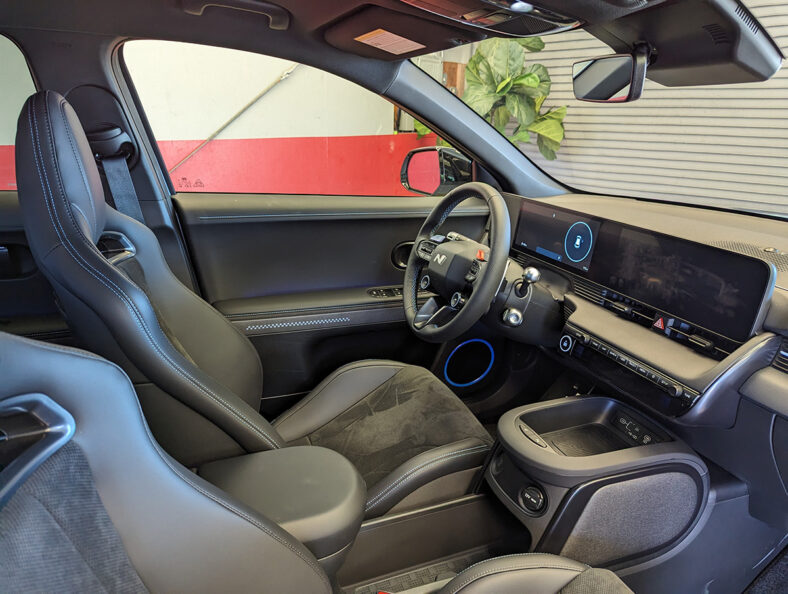
N Pedal Enhances Your Performance
Hyundai has even modified the functions of regenerative braking in the Ioniq 5 N – taking a feature exclusive to electric vehicles and discovering a way to make this feature help the car handle better. Regenerative braking is, essentially, the infamous “one-pedal driving” of electric vehicles. All of Hyundai’s electric vehicles have selectable levels of regeneration, from light, where the car coasts almost like a gasoline-powered vehicle, to heavy, where taking your foot off the accelerator pedal results in a feeling like you are actively on the brakes.
Hyundai’s N-pedal regenerative braking is tuned specifically for the track. N-Pedal has a high level of regeneration, which serves two purposes. First, regenerative braking helps maintain a charge, increasing the car’s longevity when being driven all out. Additionally, the high level of regeneration helps transfer the weight of the car towards the front tires, which is important when going into a turn. Transferring the weight over the front tires helps the front tires gain additional traction for turning.
Since regenerative braking is handled by the electric motors rather than the brake pads, this also helps reduce brake pad wear. While we were at Laguna Seca, one of the Hyundai representatives said they had to check the brake pads of the gas-powered Elantra N every night and potentially change them during the media event. With the Ioniq 5 N, he said the pads easily make it through the media event and longer, due to the decreased mechanical brake wear that results from the regenerative braking. Additionally, while most EV regenerative braking does not function under very heavy braking or when ABS kicks on, the Ioniq 5 N regenerative braking works under all of these conditions.
Related: Performance Driving on a Track: You Simply MUST DO THIS!
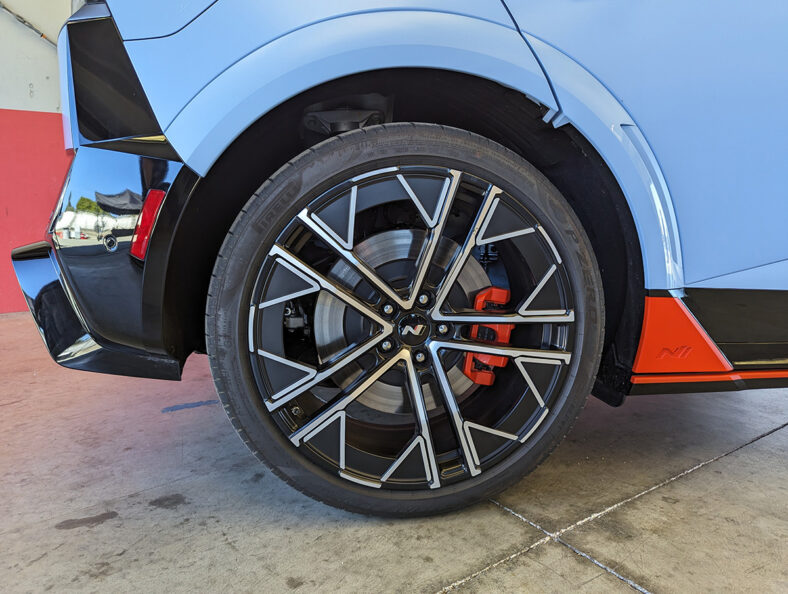
This Performance EV Has Racetrack Capability
The Nurburgring is an over-7-mile-per-lap race track in Germany. This track is the proving grounds for most manufacturer’s sports cars. Setting the production car record, or record for the class of car, at the Nurburgring is a feat in itself. No EVs have done more than one lap of the Nurburgring, simply because they either overheat or run out of charge before completing a second lap.
That is, until now. The Hyundai Ioniq 5 N was able to complete over two laps of the Nurburgring. While this is nothing compared to gasoline-powered vehicles, which thunder around the track for 24-hours straight in perhaps the most famous sports car race in the world, this is a massive feat for the EV market. This is possible due to the many adaptations on the Ioniq 5 N specifically for the race track.
8 Sexy Sports Cars that Make Great Daily Drivers

Keeping it Cool and Comfy in the Hyundai Ioniq 5 N
One of electric vehicle’s main downfalls in performance driving is overheating. The motors and batteries heat up significantly, which can cause failures. To combat this, Hyundai has focused significantly on cooling in the Ioniq 5 N. Active air flaps in the front bumper, as well as ducting in the undertray, direct air to critical areas in the drivetrain, preventing overheating during racing.
Additionally, the Ioniq 5 N is fitted with an N-Race setting. This setting allows the driver to essentially program the battery cooling strategy based on the type of racing: sprint racing (short race time) or endurance (long race time).
Even some interior features are added to assist with comfort on the race track. The front seats come straight out of the Elantra N and have additional side bolstering to hold you in place on sharp curves. The center console, as well, has padding on the sides. This is because drivers and passengers alike often find themselves bracing their knees against the center console when being tossed side to side on the race track. The extra padding helps keep your knee from getting too bruised up after a long day at the track.
Perhaps most importantly for a race car, the Ioniq 5 N is fast. It offers 601 horsepower and 545 ft-lb of torque under normal driving, but with the push of the N Grin button, the car receives 10 seconds of extra power, resulting in 641 horsepower and 568 lb-ft of torque. This boost is incredibly noticeable and gives a wonderful kick of power! After 10 seconds, this feature just needs an additional 10 seconds to recharge before it can be used again.
Even the tires on the Ioniq 5 N are designed specifically for this vehicle in a partnership between Pirelli and Hyundai. The P-Zero Elect tires are designed to handle the heavy weight and instant torque of an electric vehicle while still providing excellent grip around corners.

On Your Marks, Get Set, Charge
It’s exciting to see that Hyundai is committed to the performance EV. They know the biggest gripe from potential customers will likely be the infrastructure. After all, there aren’t many race tracks in the US with fast chargers on-site or even close by.
Hyundai is dedicated to changing this problem. They have already installed 10 fast chargers at the Inje Speedium in South Korea, which will charge the Ioniq 5 N from 10% – 80% in approximately 18 minutes. “20 minutes on track, 20 minutes charging, and repeat,” they said.
For those of us in other countries, Hyundai is already at work. They have finalized a plan to add fast chargers to the Nurburgring and are in talks with an unmentioned race track in the US. It may take some time until infrastructure is built up fully, but progress is already being made – before the Ioniq 5 N even hits the streets.
Why the focus on racing? Well, other than appealing to enthusiasts who like taking their cars to a track day, Hyundai has created the Hyundai Ioniq 5 N EN1 Cup Car – a fully race-prepped, factory-built race car based on the production Ioniq 5 N (and with the exact same power unit, actually!) built to race in a cup series against more of the same car.
The series is only in South Korea for now, but it already has 10 participating teams. With this racing series in mind, Hyundai is currently in the works with tire manufacturers to develop a racing slick specifically for EVs.

The Hyundai Ioniq 5 N is an Everyday Sports Car
So it handles well, and it is fantastic on a race track. But most of us drive our car to and from work more than anything.
The Ioniq 5 N is fitted with the same standard features as the Ioniq 5, including blind spot monitoring (and blind spot cameras), front crash warning, wireless Apple Car Play and Android Auto, highway assist with automatic lane changes, a digital key, and Hyundai Pay, to name a few. All of these features are standard, with a starting price of $66,100. Choose your color and go!
But an enthusiast’s everyday sports car is about much more than just modern conveniences, and that is where Hyundai really delivered. Electric cars don’t have gears. They accelerate purely linearly, with instant torque and a smooth pull-up to speed. This is quicker, yes, but what about the visceral joy of slamming gears?
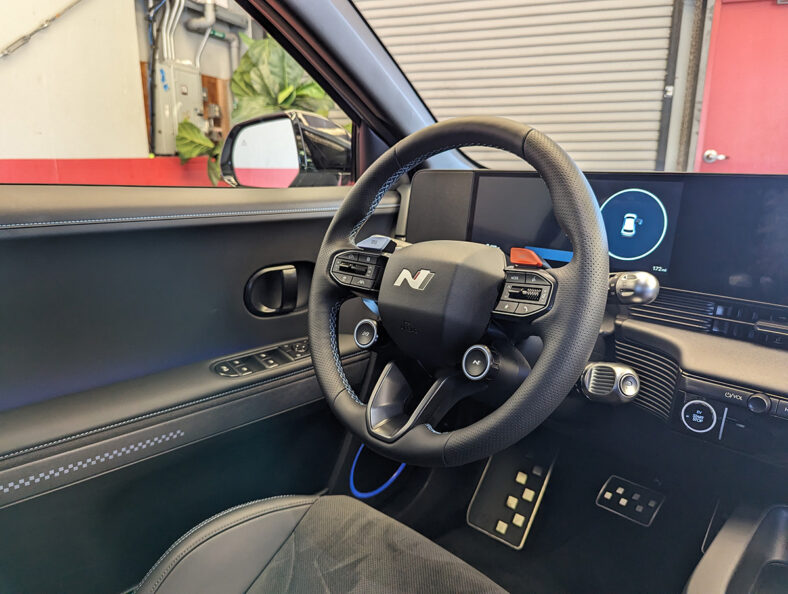
Tuned to Your Heart’s Content
Hyundai’s engineers spent countless hours tuning “gears” into the Ioniq 5 N. Operated with paddle shifters in Sport and N driving modes, each of these gears has a different torque curve, meaning they all feel different, just like a true manual transmission. If you are in fourth gear and slam your foot to the floor, it will not instantly accelerate but will feel like it bogs down just like a real manual would. But if you downshift to second and floor it, the car goes (and I mean, goes).
The shifts aren’t smooth, and this is on purpose to mimic the rough shift of other sports cars. If you want the feel of gears but don’t want to manually shift gears, the car can be operated in automatic mode, where the “gears” shift automatically. The car will also automatically downshift when it slows down, keeping the RPMs high for greater torque.
While the manual gear feel is nothing short of incredible (if I closed my eyes, I might even guess I was in a gasoline-powered stick shift!), the automatic shifting did behave a little strangely at times. When you drive an automatic gas-powered car, and you floor the gas pedal, the car will automatically downshift in order to accelerate quickly. The Ioniq 5 N tries to mimic this, but I did notice it skipped a few gears a couple of times. This may be a little nit-picky, as the rest of the automatic driving was impeccable.
If you are not a fan of the shifting feel, the car can be operated with no “gears,” as well.
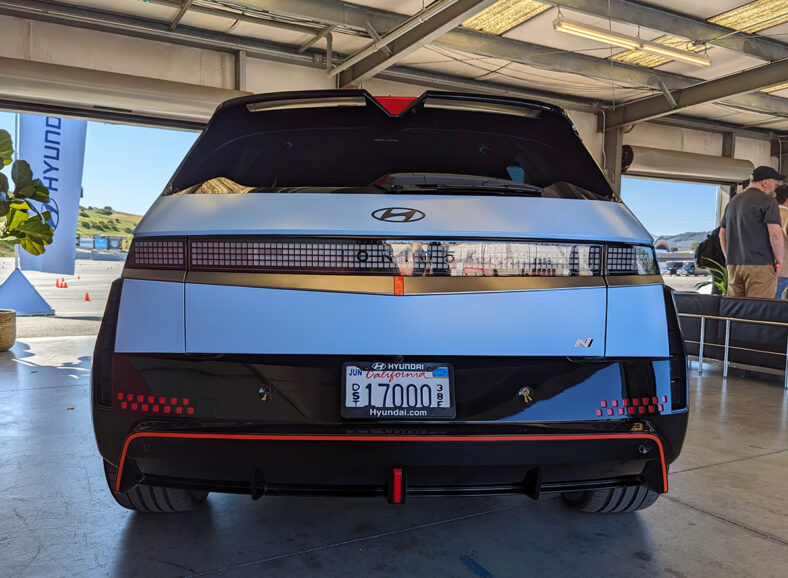
Oh, Those Sweet, Sweet Sounds
Along with the gears, the Ioniq 5 N makes noise—and not that alien, whirring noise that EVs make when backing up. Equipped with interior speakers and speakers at the front and rear of the car, the 5 N can make engine and exhaust noise.
Hyundai could have programmed any sound to the Ioniq 5 N’s sound system. They could have made it sound like a screaming, high-revving Formula One engine. But, wanting to stay true to their brand, Hyundai opted to model the sound after the Elantra N. This is called N Active Sound +.
When turned on, the engine and exhaust rev with the “gears,” and the exhaust even pops and burbles! Besides the Ignition sound mode, the Ioniq 5 N is equipped with two other unique, high-performance sound settings from the factory: Evolution and Supersonic. The gears and exhaust noises are not necessary. In fact, the gear shifts make the car accelerate slower. Hyundai created these features solely for the fun of it!
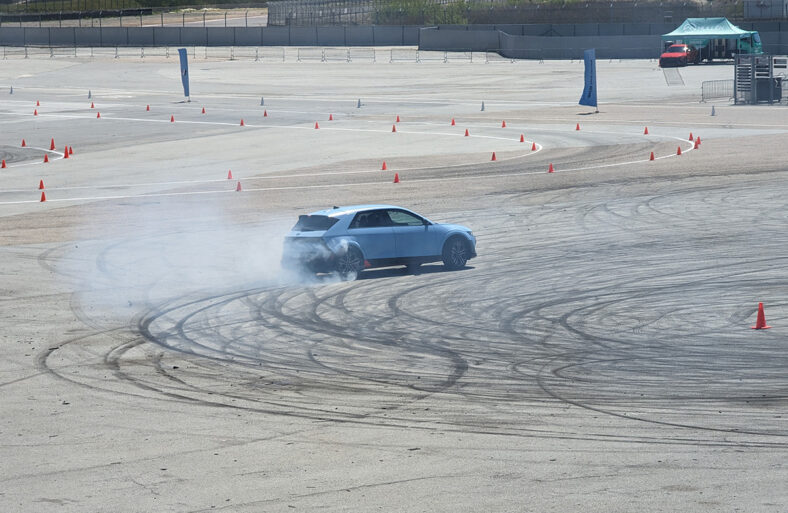
The Ultimate Meeting: Ioniq 5 N and Laguna Seca
So, what does this mean for the Hyundai Ioniq 5 N in real life?
I had the opportunity to test the small SUV on the road and on Laguna Seca, a world-renowned race track. On the street, the Ioniq 5 N is comfortable, quiet, and convenient. The ride is noticeably rougher than other EVs due to the stiffer suspension, but twisty mountain roads are unbelievably fun. The car itself makes me want to “hoon” (or in other words, be a rogue street racer). It is so fun and peppy that I just have to step on it, toss it around a corner or two, and resist the urge to do donuts.
On the track, the Ioniq 5 N exceeded my expectations. It isn’t just good “for an electric car.” It is good. The adjustable rear-wheel bias creates a significant difference in the car’s cornering ability and ability to slide. It handles curves like a champ, unlike any other SUV I’ve ever had on track, and isn’t easily upset by dips, bumps, and curbs. While it is a 4,861 lb car, it doesn’t feel like an almost 5,000 lb car. It feels heavy, but not that heavy. As the first iteration of a racing EV, it is limited in its endurance at full speed, but Hyundai is dedicated to continuing its research and improving on this front.
The Ioniq 5 N is a true Jekyll and Hyde—quiet, contained, and comfortable on the streets but rowdy, shouty, and capable on the track. While not an exact substitute for a gas-powered race car, Hyundai’s work in embodying the soul of the enthusiast sports car is apparent.
Have a thought or comment? Share it with us on social media! You can find us on Instagram, Facebook, Twitter and LinkedIn. And be sure to sign up for our email newsletter!
More About:Car Reviews Electric Cars
